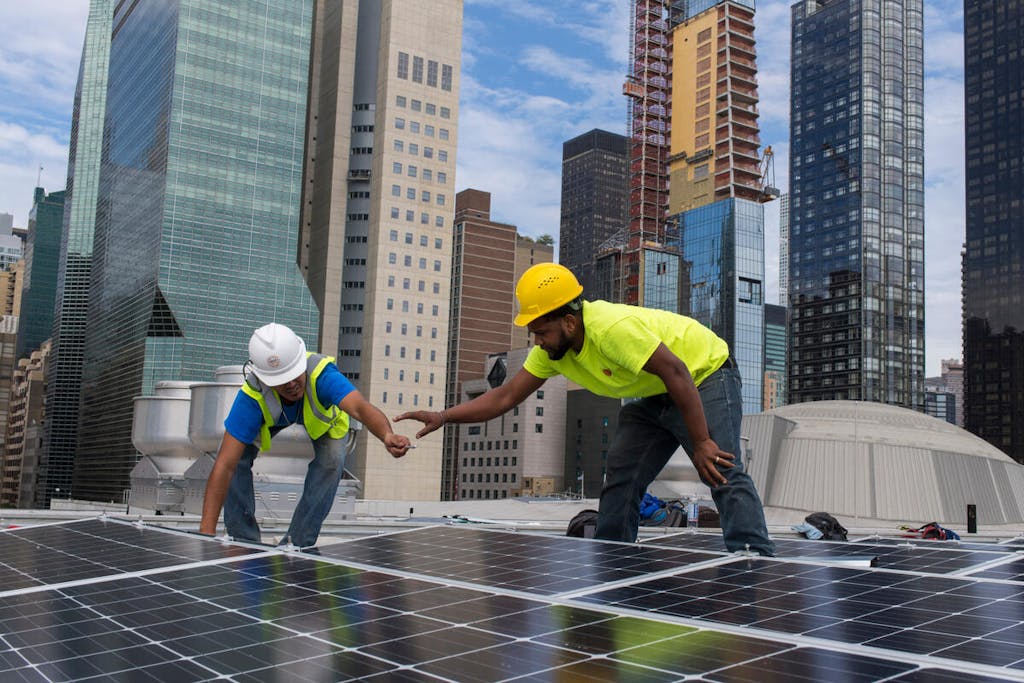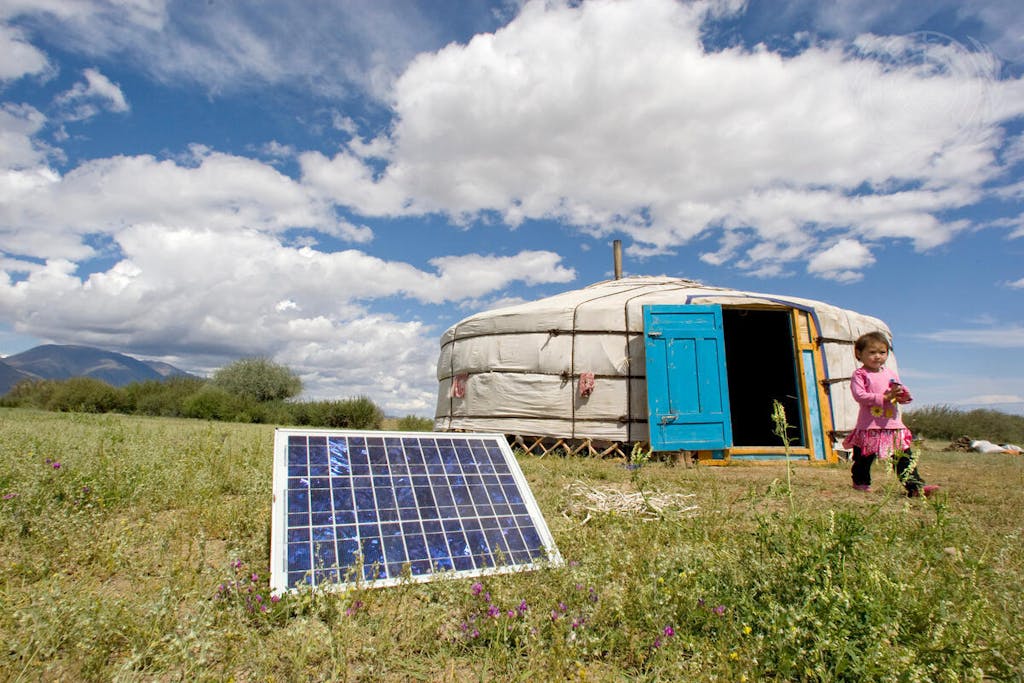As the United States rejoins the Paris Agreement, the imperatives of combating climate change and achieving the Agreement’s goals have never been clearer. And the economic opportunities of building a green, sustainable global economy are also more apparent than ever. As the world races toward COP26 in Glasgow amid a global pandemic and economic crisis, the U.S. can and must play a critical role in helping to put itself and the world on this green path of economic recovery.
People all over the world are enduring more unprecedented effects of climate change, from debilitating winter storms in Texas to deadly glacier bursts in India. Without much greater action to stabilize our climate, these extreme effects will only get worse.
Curbing the toll on lives and livelihoods is justification enough, but there are many other reasons for countries to recommit to the Paris climate agreement, the historic action plan they all signed up to just over five years ago. It’s essential for igniting — and protecting — progress across the Sustainable Development Goals (SDGs), including for human health, ecosystems, and security. It also provides a shared blueprint for planetary sustainability and resilience as governments begin to implement economic recovery plans in light of COVID-19. Last year, UN Secretary-General António Guterres proposed six climate-related actions to recover better from the pandemic, including promoting sustainable green jobs and green economies.
With the United States back in the Paris Agreement after its formal withdrawal late in 2020, the Biden administration is aggressively pursuing climate action. As Special Presidential Envoy for Climate John Kerry put it recently, a “zero emissions future offers huge opportunity for business, for clean, green jobs and economic growth.”
Here are six ways that achieving the goals of the Paris Agreement can drive economic growth:
1. Economic benefits up to $616 trillion by 2100. Ambitious climate action across all sectors could deliver sizable net global economic gains compared with business as usual. In the United States, the nine northeastern states that participate in the Regional Greenhouse Gas Initiative gained $1.4 billion of net economic benefit in just three years (2015-2017). Similarly, investments in energy efficiency can lead to significant economic gains. Wisconsin’s energy efficiency program, for example, added almost $600 million to the state’s economy over 10 years. And while the economic benefits of climate action can be considerable, the cost of inaction is perhaps even more staggering. According to a recent study, if countries fail to meet their nationally determined contributions (NDCs), the world could face a global loss of around $150 trillion to $792 trillion by 2100 — the equivalent of one to seven times global GDP.
2. Millions of new jobs. Global investments in renewable energy in the COVID-19 recovery period can generate new jobs while ensuring that our energy systems are aligned with climate objectives. The International Renewable Energy Agency estimates that accelerated green energy transition plans could produce global gains of $98 trillion by 2050 while quadrupling renewable energy jobs to 42 million. Similarly, investing in energy transition technologies can create almost three times as many jobs as fossil fuels do for each million dollars of spending. The job opportunities generated by states in the U.S. Climate Alliance, a group of 25 governors dedicated to meeting the targets of the Paris Agreement, set a clear example. Michigan, which joined the alliance in February 2019, boasts over 125,000 clean energy jobs, the highest number of clean energy jobs in the Midwest from 2017 to 2018.

3. Fewer costly climate-related disasters. Over the past two decades, responding to these disasters has cost nearly $2.3 trillion. Global economic losses associated with extreme weather events increased by over 150% compared with 1978-1997, according to a report by the UN Office for Disaster Risk Reduction. In the United States alone, the cost of flood damage caused by heavy rainfall amounted to $75 billion over the past three decades — a third of which can be attributed to the impacts of climate change. This reality is especially dire for low-lying island states and other vulnerable countries on the front lines of hurricanes and sea level rise.
The economic losses associated with extreme weather events put a spotlight on the need to scale up investments in adaptation to build long-term climate resilience. At the first global Climate Adaptation Summit in January, Guterres called for 50% of climate finance provided by developed countries and multilateral development banks to be allocated to adaptation and resilience efforts in developing countries, stating, “adaptation cannot be the neglected half of the climate equation.” Ambitious climate finance efforts now can avert costly impacts later. Correspondingly, investments in actions to lessen climate change will help the world avoid the mounting costs of these climate impacts, which based on current trends in emissions could amount to over $7.9 trillion by 2050.
4. Less air pollution. The associated toll on health and economy from air pollution is extremely high. According to the World Health Organization (WHO), air pollution is responsible for more than 7 million premature deaths every year — that’s more than many other health risks, including malnutrition, alcohol use, and physical inactivity. And that burden adds up. In terms of costs, air pollution takes a heavy toll on the global economy: more than $5 trillion every year in welfare costs and $225 billion in lost income.
As COVID-19 has forced people to spend more time indoors, exposure to indoor air pollutants has also increased. Pollutants produced by increased cooking are a particular source of contamination and highlight a need to make clean energy and green technology accessible to all. A study by the Harvard T.H. Chan School of Public Health has also found an association between long-term exposure to air pollution and higher COVID-19 mortality rates. Most climate mitigation policies would reduce many of the same pollutants that cause air pollution, creating win-win-win solutions for health, climate, and economy. For example, the U.S. Clean Power Plan alone could deliver $39 billion of net benefits in 2030 thanks to the avoided health impacts of local air pollution.

5. Immense energy savings. Climate action can slash the price we are now paying and incurring by subsidizing the fossil fuel industry to the tune of 0.4% of global GDP: As Mr. Guterres described at the R20 Summit, subsidizing the fossil fuel industry means spending taxpayers’ money to “boost hurricanes, to spread droughts, to melt glaciers, to bleach corals: to destroy the world.”
6. Fewer investment risks. Investors are sending a clear message: Act now. Ahead of the 2019 UN Climate Action Summit, a group of 515 investors managing assets worth $35 trillion — nearly half of the world’s invested capital — urged leaders to act on the climate crisis with the “utmost urgency.” These investors recognized that climate change threatens stability in our societies, economies, and environment. Since then, a number of initiatives have emerged with the shared understanding that climate change must be incorporated into all financial decisions. The Net Zero Asset Owner Alliance, launched at the Climate Action Summit, has become a climate leadership group of 33 institutional investors, representing over $5.1 trillion in assets, committed to transitioning their portfolios to net zero GHG emissions by 2050.
Many companies, too — including over 400 businesses committed to reducing emissions in line with the 1.5°C target as part of the UN Global Compact — understand that the best path forward is the Paris Agreement. Asset managers are joining this growing effort. In his 2021 letter to CEOs, BlackRock Chairman and CEO Larry Fink stressed the role of climate change in long-term strategic business leadership. By prioritizing environmental and social consciousness, a number of other powerful asset managers are now making climate change central to their investment strategies.
The evidence is overwhelming: Climate action under the Paris Agreement will drive sustainable economic growth, and it is imperative that the United States lead in the international arena of climate action as it reenters this historic accord.
TAKE ACTION AND LEARN MORE
If you live in the U.S., encourage your governor to step up climate action and join the U.S. Climate Alliance.
If you’re interested in learning more about the threat of global warming of 1.5 °C above preindustrial levels, read the latest Intergovernmental Panel on Climate Change special report.
An earlier version of this blog post, was published in 2019. Read it here.
Featured Image: U.S. Department of Energy




 View All Blog Posts
View All Blog Posts


